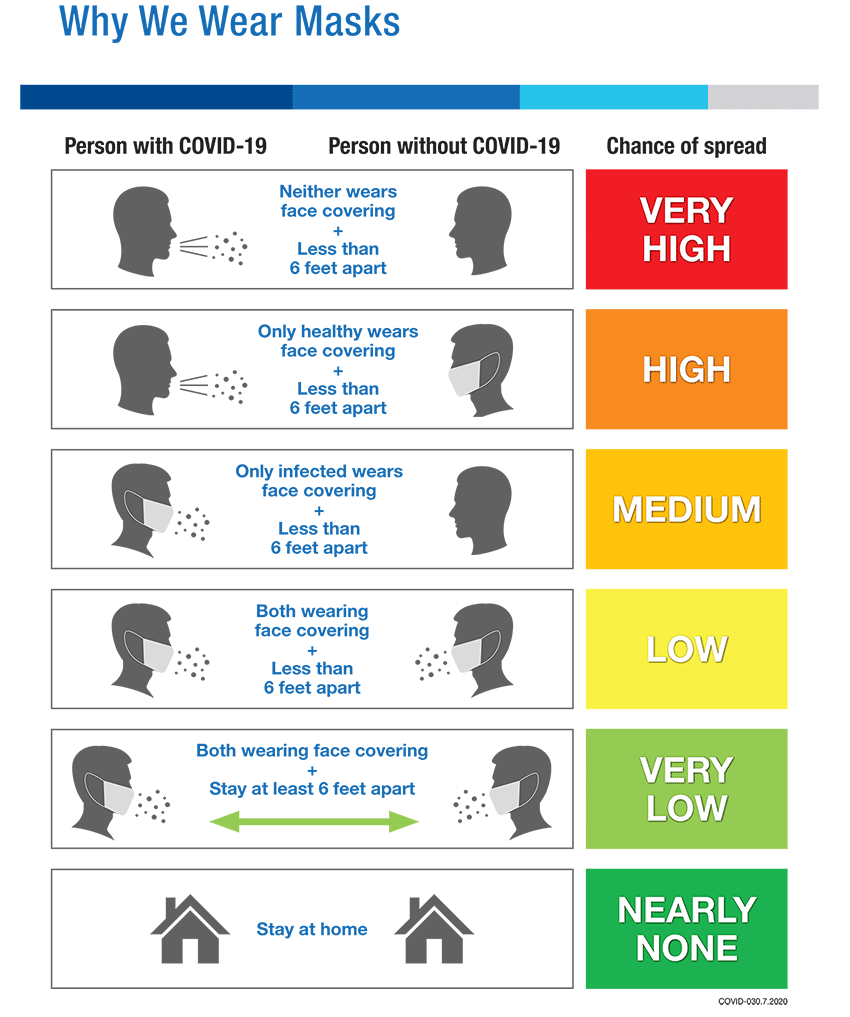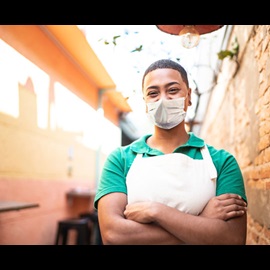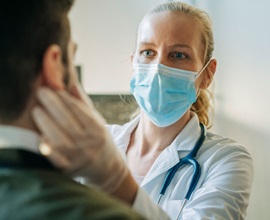
The Science Behind Masks and Face Coverings
At St. Luke's, we've receive many inquiries from community members and leaders around the effectiveness of masks and face coverings. There is a lot of misinformation circulating today, so it's important to review the latest scientific information. Please review our answers to the most frequently asked questions below. We include citations to the evidence-based science that informed our responses.
Frequently Asked Questions
Click each question below for its answer:
[i] He X, et al. Temporal dynamics in viral shedding and transmissibility of COVID-19. Nat Med 2020;26:672–5.
[i] Konda, et al. Aerosol Filtration Efficiency of Common Fabrics Used in Respiratory Cloth Masks. ACS Nano 2020;14: 6339−6347.
[ii] Zhao, et al. Household Materials Selection for Homemade Cloth Face Coverings and Their Filtration Efficiency Enhancement with Triboelectric Charging. Nano Lett. 2020, 20, 7, 5544–5552.
[iii] Gandhi, et al. Facial Masking for Covid-19 — Potential for “Variolation” as We Await a Vaccine. N Engl J Med 2020; 383:e101 DOI: 10.1056/NEJMp2026913
In the basic science realm, a recent study demonstrated that individuals who had non-COVID-19 coronavirus infection (causes the common cold) demonstrated that wearing a surgical mask significantly reduced the amount of coronavirus emitted in droplets and aerosols into the air around the infected patient. This coronavirus virus (similar in size to the coronavirus that causes COVID-19) was detected in up to 40% of respiratory droplets in surrounding air samples from individuals NOT wearing face masks. No coronavirus was detected in air samples collected from participants wearing face masks.[i] In addition, homemade face coverings made from household fabrics may be less effective compared with commercially manufactured cloth and surgical masks, but they still can substantially limit dispersion of exhaled infectious respiratory particles, including respiratory droplet-sized particles containing COVID-19.[i]
[i] Leung, et al. Respiratory virus shedding in exhaled breath and efficacy of face masks. Nature Medicine. 2020.26:676–680.
[i] Verma, et al. Visualizing the effectiveness of face masks in obstructing respiratory jets. Phys Fluids (1994). 2020;32(6):061708. doi:10.1063/5.0016018
Real world examples include case series as well as larger studies.
Among the case series, a well-known case study describes a man who flew from China to Toronto and subsequently tested positive for COVID-19. He had a dry cough and wore a mask on the flight, and all 25 people closest to him on the flight tested negative for COVID-19.[i] In another noteworthy case series, cotton facial coverings or masks were required in a county in Missouri. One hair stylist (A) developed COVID and transmitted it to a coworker (B) with whom she took non-mask wearing breaks with between clients. Otherwise both stylists wore masks while working with clients. Even though these stylists worked for a combined total of 13 days and with 139 clients while infected with COVID, none of their clients or other stylists, who were also required to wear masks or cloth facial coverings, developed COVID. However, 4 of 4 household contacts of stylist A did get COVID infection (masks presumably were not worn when at home).[ii]
[i] Schwartz, et al. Lack of COVID-19 transmission on an international flight. CMAJ 2020. 19(15);E410.
[ii] MMWR / July 14, 2020 / Vol. 69
Larger studies have also shown benefits in populations of people. A recent meta-analysis by Liang, et al estimated that masks could reduce viral infections by 80% in healthcare providers (HCP) and 47% in the community. However, they noted that studies from Asia suggest greater benefit from masks likely due to greater consistency in use compared to studies done in Western countries.[i] A meta-analysis by Chu, et al[ii] estimated a possible 85% reduction in transmission with the use of any N95, mask, or 12-16 layer cotton mask in HCP and about a 44% reduction for mask use in the community.
[i] Liang M, et al. Travel Med and Infect Dis 2020 https://doi.org/10.1016/j.tmaid.2020.101751.[ii] Chu, et al. Physical distancing, face masks, and eye protection to prevent person-to-person transmission of SARS-CoV-2 and COVID-19: a systematic review and meta-analysis. Lancet 2020; 395: 1973–87.
Finally, studies have been conducted on the effectiveness of policies or mandates around mask use. In a study of the largest health care system in Massachusetts, a leadership-mandated policy of universal masking for all health care workers (HCWs) and patients on rates of SARS-CoV-2 infection was evaluated. At the time universal masking was started (late March 2020), new infections in HCWs was increasing exponentially, reaching 21.3% of overall staff (increase of 1.2% per day). Following universal masking, positive test results began to drop after two weeks to 14.7%, and 11.5% by four weeks (about 0.5% per day). The authors rightly note that other community-wide and hospital-specific interventions (distancing, washing hands, testing, etc.) also played a role, but only after universal masking was in effect for one week did infections in HCWs start to decline.[i] And in an additional recent study, COVID-19 growth rates before and after face mask mandates were compared in 15 states and the District of Columbia, demonstrating that required mask use led to a slowdown in daily COVID-19 infections. In the first five days after a mandate, the daily growth rate slowed by 0.9% compared to before mandate. At three weeks, the daily growth rate had slowed by 2% (keeping in mind that overall infection rates were 10-15%).[i]
[i] Lyu, et al. Community Use of Face Masks And COVID-19: Evidence from A Natural Experiment of State Mandates in the US. Health Affairs 2020. 39;8: 1–7. https://doi.org/10.1377/hlthaff.2020.00818[i] Wang, et al. Association between universal masking in a health care system and SARS-CoV-2 positivity among health care workers. JAMA. Published online July 14, 2020. doi:10.1001/jama.2020.12897
[i] Mueller, et al. Assessment of Fabric Masks as Alternatives to Standard Surgical Masks in Terms of Particle Filtration Efficiency. Found at: https://www.medrxiv.org/content/10.1101/2020.04.17.20069567v2.full.pdf
Recent modeling from the Institute of Health Metrics and Evaluation has suggested that if 95% of people wore coverings, we could avoid 33,000 deaths by October 1. In addition, wearing face coverings is more impactful in reducing the spread than Stay-at-Home Orders or strict lockdowns.
A face covering should be worn over both the mouth and nose, covering below the chin. It should have a close fit to your face, not too snug and not too loose. Before you put on your face covering, ensure it and your hands are clean. An excellent video on mask wearing is available from PBS: How Well Do Masks Work.
View more info on how to wear a mask
For masks to be effective, they must be worn consistently and correctly, fitting closely to the face, and be made of fabrics that are effective in filtering respiratory droplets made by breathing, talking and coughing. A good double-layered cloth face mask is very effective. If available, a surgical mask will achieve similar results. The most important factor is if they fit comfortably covering the nose and mouth. A covering that is not worn properly is ineffective. N95s are not necessary unless used in medical situations. Any face masks with valves, such as some N95s, are not recommended due to the ability to transmit from the carrier out through the valves, thus not protecting those around you. If you wear a valved mask, you must also wear a surgical or cloth mask to protect those around you.
In your car, no, unless there is a vulnerable person in the car with you that you do not generally have close contact with (e.g., someone you do not live with). Any time you are in public and physical distancing becomes a challenge, face coverings should be worn.
Face coverings should be washed regularly if they made of reusable materials (e.g., cloth), depending on the frequency of use. Cloth face coverings can be effectively cleaned in a washing machine on a normal setting. One-time use masks should be changed out frequently.

Related Information
-

How to Wear a Mask
Learn how to make wearing a mask as comfortable as possible and what to avoid while handling or wearing your mask.Read More -

COVID-19 Myths and Misconceptions
Recently, St. Luke's has seen an increase in rumors and misconceptions around our response to COVID-19, from recommending face coverings to the positive case count and reimbursement. These FAQs are meant to respond to these concerns in the community.Read More
COVID-19 Resources
Navigating COVID-19 Together
St. Luke's is prepared to support our patients and community as we enter the fall flu season with COVID-19 still spreading across Idaho. Our commitment to safe care includes coronavirus testing, visitor screening, enhanced safety practices and more.

